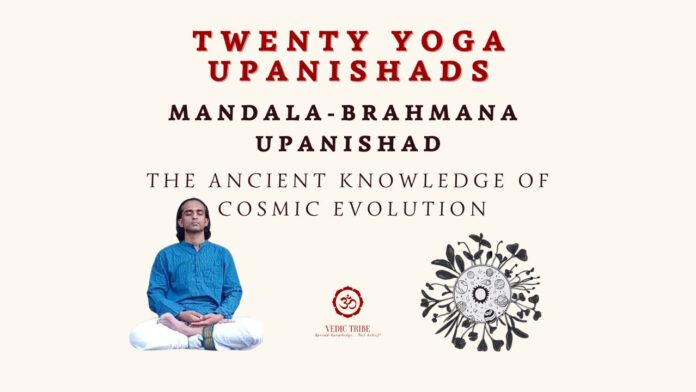The ancient knowledge of cosmic evolution:
In the previous article, we discussed the Yogachudamani Upanishad. In this article, we will discuss Mandala-brahmana Upanishad.
This Upanishad contemplates four different spaces within which the cosmos evolved.
Key Concepts of the Mandala-Brahmana Upanishad:
Ashtanga Yoga: The Ashtanga Yoga of this Upanishad is similar to Patanjali’s Yoga Sutras.
The Solar Plane: The Upanishad associates the concept of “Mandala” with the solar plane of existence. It is one of the four spaces – Akasha, Parakasha, Mahakasha and Suryakasha. It indicates different stages of cosmic creation in the context of space & Brahman’s play in it.
Akasha:
Space of unmanifested energy: Akasha in this Upanishad’s context is not atmosphere or outer space. But it is the space of darkness; the space where energy has not yet manifested.
Primordial space: This is the primordial space, devoid of matter and energy. It is a state of pure potential, a cosmic womb from which the universe emerges. In modern cosmology, this could be likened to the state of the universe immediately after the Big Bang.
Adobe of creation: In the language of contemporary physics, it is a space without matter or energy but only quantum fields. Slight fluctuation in these fields create matter and energy. Until then this is the space of no activity.
Brahman the cosmic consciousness is the only conscious being observing this “Akasha”. At the advent of creation Brahman brings matter & energy into existence out of this “Akasha”.
Parakasha:
Flux: Parakasha in this this Upanishad’s context – is the space filled with flood of fire.
Raw energy: This is the space of intense energy and activity, where the universe begins to take shape. It’s a fiery, chaotic state, filled with the raw energy of creation. This aligns with the early stages of the Big Bang, when the universe was incredibly hot and dense.
Early universe: In the language of contemporary cosmology, the conditions were so extremely hot that particles as we know them couldn’t exist. Instead, there was a primordial soup of energy, from which particles like quarks and leptons eventually emerged as the universe cooled down.
In the Vedic tradition, the cosmic consciousness behind this interplay of energy and matter in Parakasha – is observed and meditated upon.
Mahakasha:
Radiant light: Mahakasha in this Upanishad’s context – is the space filled with radiant light.
Our universe: This is the space filled with galaxies and stars, a vast expanse of luminous matter. It represents the universe as we currently observe it, with billions of celestial bodies. These came to being several hundred million years after the Big Bang, as the universe began to cool down enough for matter to coalesce into stars and galaxies.
Cosmic dawn: In the language of contemporary cosmology, this phase is called “cosmic dawn”.
In Vedic tradition, this dance of radiant light is observed in Mahakasha and the role of Brahman is meditated upon
Suryakasha:
Realm of the Sun: This is the space illuminated by the sun, symbolizing the present cosmic cycle.
Adobe of life: It represents our solar system and the Earth, where life thrives.
In Vedic tradition, this adobe of Sun is worshipped as Suryakasha and the role of Brahman as Savithr is meditated upon
Key takeaways:
– Study Mandala Brahmana Upanishad and adopt teachings of this Upanishad in your meditative practices.
– Also study cosmology and appreciate the meditative insights of ancient Rishis captured in Vedic literature like this Upanishad.
In the next article, we will discuss – “Advaya -taraka Upanishad”.
Madhwesh K
Vedic Tribe

